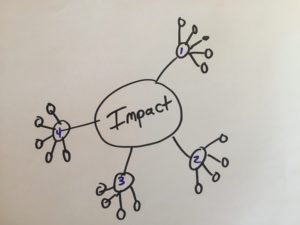What types of impact are possible? If you can imagine a kind of social change, games are there. Thousands of possibilities exist — from tiny to massive, global to local, economic to sociological.
It is tempting to map them all:

But then we lose perspective. What we need is the big picture. Especially to address a few of the most important needs in our field:
- To orient new funders and producers. What options are possible? Where to begin? The goal is to articulate the forest, not just trees with deep roots.
- To compare similar projects, i.e., based on similarities in logic models and theories of change, not content areas
- To reduce friction in the field, e.g., talking past each other
The dream is more like:

What’s the difference?
- Organizes with big categories
- Less overwhelming
- Hints at layers of depth
But what should the umbrella nodes and categories be? If we’re not proactive, one group may define impact for the field leaving out a crucial breadth of perspectives and practices:
Any one discipline in isolation has blinders, leading to some classic problems:
- Not inclusive of people (splinters the movement)
- Not inclusive of impact types — overlooks key forms (e.g., sociology rarely invoked by psychologists)
- Confuses truth with being useful; in fact, narrow truths often inhibit broader understanding, and broad understanding may require some deliberate and strategic ambiguity
Wanting to create a useful understanding of impact means that this a design challenge, with obstacles to be overcome (like getting the framing right). Solutions to this design challenge will be successful if they:
- change how we design
- bring people together (cohesion)
- foster more useful debate (the right kind of disagreements)
What does it look like? Watch for our next post…


[…] The range of impact […]